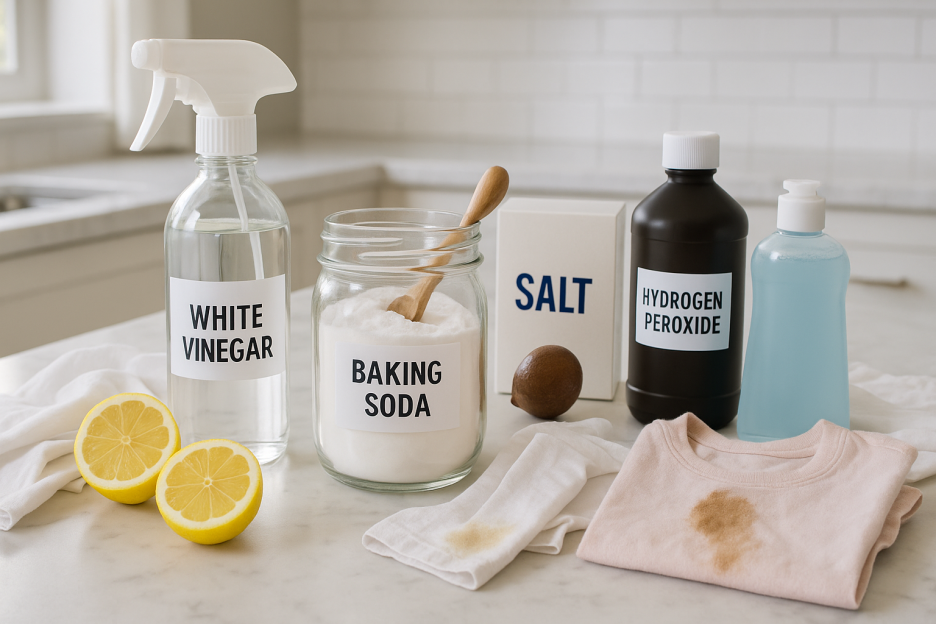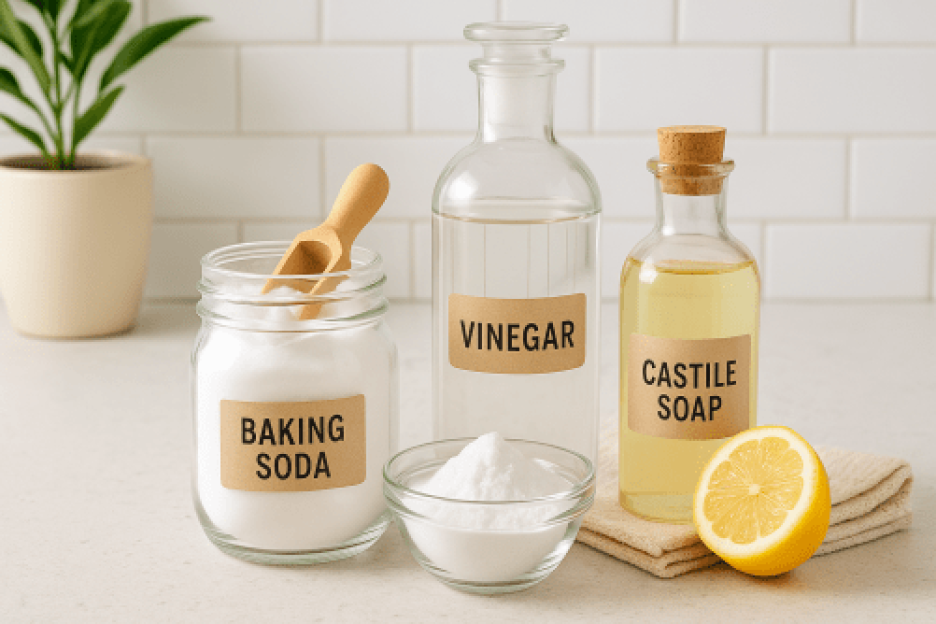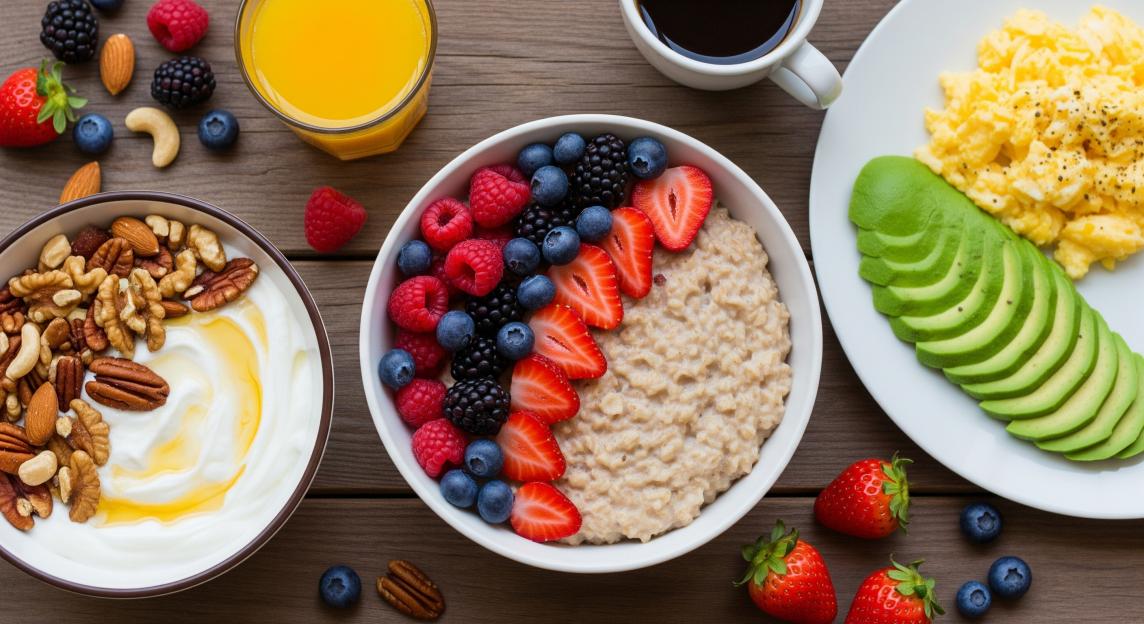That moment when you spill coffee on your favorite white shirt or your child comes home with grass stains on their new jeans-it’s the kind of heart-sinking feeling every parent and homeowner knows all too well.
But before you reach for harsh chemical stain removers or consider throwing that garment away, nature has already provided you with an arsenal of powerful, gentle solutions that have been trusted for generations.
Why Choose Natural Stain Removers Over Chemical Alternatives?
Natural stain removers offer numerous advantages over their chemical counterparts, making them the preferred choice for health-conscious households across America. These eco-friendly alternatives are not only safer for your family and pets but also gentler on your clothes, helping preserve fabric integrity and color vibrancy.
Environmental Benefits of Natural Cleaning Solutions
When you choose natural stain removal methods, you’re making a positive impact on the environment. Unlike synthetic cleaners that contain phosphates, sulfates, and other harmful chemicals, natural ingredients biodegrade quickly without polluting waterways or harming aquatic life.
Cost-Effective Household Solutions
Most natural stain removers use common household items you likely already have in your kitchen pantry. This means you can tackle stains immediately without expensive trips to the store or investing in specialty cleaning products.
Safety for Sensitive Skin and Allergies
For families with sensitive skin, allergies, or respiratory conditions, natural stain removers provide effective cleaning without triggering adverse reactions. These gentle formulations are particularly beneficial for children’s clothing and bedding.
The Science Behind Natural Stain Removal
Understanding how natural ingredients work to remove stains helps you choose the right method for different types of stains. Most stains fall into three categories: protein-based (blood, sweat), tannin-based (coffee, wine), and oil-based (grease, makeup).
How Natural Enzymes Break Down Stains
Many natural ingredients contain enzymes that break down specific stain components. For example, the bromelain in pineapple juice effectively breaks down protein stains, while the citric acid in lemon juice tackles mineral deposits and brightens fabrics.
pH Levels and Stain Removal
Different stains respond to different pH levels. Acidic solutions like white vinegar work well on alkaline stains, while alkaline solutions like baking soda neutralize acidic stains. This chemical balance is key to effective natural stain removal.
Top 15 Natural Stain Removers for Every Type of Stain

1. White Vinegar: The Ultimate All-Purpose Stain Fighter
White vinegar stands as the most versatile natural stain remover in your cleaning arsenal. Its acidic nature makes it particularly effective against deodorant stains, sweat marks, and mineral deposits from hard water.
How to Use:
- Mix equal parts white vinegar and water
- Apply directly to the stain
- Let sit for 30 minutes before washing
- For stubborn stains, use undiluted vinegar
Best For: Deodorant stains, sweat marks, hard water stains, mildew, and general odor removal.
2. Baking Soda: The Gentle Abrasive Powerhouse
Baking soda’s alkaline properties make it excellent for neutralizing acidic stains while its mild abrasive action helps lift embedded dirt and grime from fabric fibers.
How to Use:
- Create a paste with baking soda and water
- Apply to stain and gently rub in circular motions
- Let sit for 2-4 hours or overnight for tough stains
- Rinse thoroughly before washing
Best For: Grease stains, oil-based stains, food spills, and general freshening of clothes.
3. Lemon Juice: Nature’s Bleaching Agent
Fresh lemon juice contains natural citric acid that acts as a gentle bleaching agent, making it perfect for brightening whites and removing stubborn stains from light-colored fabrics.
How to Use:
- Apply fresh lemon juice directly to the stain
- Sprinkle salt over the juice for extra cleaning power
- Place in direct sunlight for 1-2 hours
- Rinse and wash as usual
Best For: Sweat stains, yellowing on white clothes, rust stains, and general brightening.
4. Hydrogen Peroxide: The Oxygen-Powered Stain Buster
Hydrogen peroxide releases oxygen when it contacts organic materials, effectively breaking down protein-based stains and brightening fabrics naturally.
How to Use:
- Use 3% hydrogen peroxide solution
- Apply directly to the stain
- Let sit for 10-15 minutes
- Rinse thoroughly before washing
Best For: Blood stains, sweat stains, yellowing, and protein-based stains.
Safety Note: Test on a hidden area first, as hydrogen peroxide can lighten some fabrics.
5. Salt: The Immediate Response Solution
Salt works by absorbing liquids and preventing stains from setting deep into fabric fibers. It’s most effective when applied immediately after a spill occurs.
How to Use:
- Pour salt generously over fresh liquid stains
- Let sit for 5-10 minutes to absorb the liquid
- Brush off excess salt
- Rinse with cold water and wash normally
Best For: Red wine stains, blood stains, sweat stains, and any fresh liquid spills.
6. Cornstarch: The Oil Absorption Specialist
Cornstarch excels at absorbing oil-based stains, making it invaluable for treating makeup, cooking oil, and grease stains on clothing.
How to Use:
- Sprinkle cornstarch generously over the oil stain
- Let sit for 30 minutes to 2 hours
- Brush off the powder
- Apply liquid dish soap to remaining stain
- Wash in warm water
Best For: Grease stains, oil stains, makeup stains, and butter or cooking oil spills.
7. Club Soda: The Fizzy Stain Lifter
The carbonation in club soda helps lift stains from fabric fibers, while its neutral pH makes it safe for most fabrics and colors.
How to Use:
- Pour club soda directly onto the fresh stain
- Blot gently with a clean cloth
- Repeat until no more stain transfers to the cloth
- Rinse with cold water
Best For: Red wine stains, coffee stains, juice spills, and fresh food stains.
8. Liquid Dish Soap: The Grease-Cutting Champion
Gentle liquid dish soap is designed to cut through grease and oil, making it excellent for treating oily stains on clothing.
How to Use:
- Apply a small amount directly to the stain
- Gently work into the fabric with your fingers
- Let sit for 15-30 minutes
- Rinse with warm water and wash normally
Best For: Grease stains, oil-based stains, makeup stains, and food stains.
9. Aspirin: The Surprising Stain Remover
Aspirin contains salicylic acid, which helps break down protein-based stains and can brighten yellowed fabrics.
How to Use:
- Crush 2-3 aspirin tablets into powder
- Mix with a small amount of water to form a paste
- Apply to the stain and let sit for 2-3 hours
- Rinse and wash normally
Best For: Sweat stains, blood stains, and yellowing on white clothes.
10. Milk: The Gentle Protein Stain Fighter
Fresh milk contains proteins and fats that can help break down certain types of stains, particularly ink stains.
How to Use:
- Soak the stained area in cold milk for 30 minutes
- Gently rub the fabric together
- Rinse with cold water
- Wash as usual
Best For: Ink stains and some protein-based stains.
11. Meat Tenderizer: The Enzyme Powerhouse
Unseasoned meat tenderizer contains enzymes that break down protein-based stains effectively.
How to Use:
- Mix unseasoned meat tenderizer with cold water to form a paste
- Apply to the stain and let sit for 30 minutes
- Rinse thoroughly with cold water
- Wash normally
Best For: Blood stains, sweat stains, and other protein-based stains.
12. Toothpaste: The Surprising Stain Solution
White, non-gel toothpaste contains mild abrasives that can help remove certain types of stains from clothing.
How to Use:
- Apply white toothpaste to the stain
- Gently rub with an old toothbrush
- Let sit for 10-15 minutes
- Rinse with cold water and wash normally
Best For: Crayon marks, makeup stains, and some food stains.
13. Shaving Cream: The Foam Fighter
The surfactants in shaving cream help break down oils and lift stains from fabric fibers.
How to Use:
- Apply shaving cream directly to the stain
- Let sit for 30 minutes
- Rinse with cold water
- Wash as usual
Best For: Makeup stains, oil-based stains, and some food stains.
14. Ice Cubes: The Hardening Helper
Ice cubes help harden certain types of stains, making them easier to scrape off without spreading.
How to Use:
- Apply ice cube directly to the stain until it hardens
- Scrape off hardened material with a spoon or knife
- Treat remaining stain with appropriate natural remover
- Wash normally
Best For: Gum, candle wax, and other sticky substances.
15. Vodka: The Odor-Eliminating Option
Vodka’s alcohol content helps break down oils and eliminates odors from clothing.
How to Use:
- Pour vodka directly onto the stain
- Let sit for 15-20 minutes
- Blot with a clean cloth
- Rinse and wash normally
Best For: Odor removal, some oil-based stains, and fresh spills.
Specific Stain Removal Techniques by Stain Type
Blood Stain Removal Methods
Blood stains require immediate attention and cold water to prevent the proteins from setting into the fabric.
Method 1: Hydrogen Peroxide
- Rinse the stain with cold water immediately
- Apply 3% hydrogen peroxide directly to the stain
- Let it foam for 30 seconds
- Rinse thoroughly with cold water
- Repeat if necessary
Method 2: Salt and Cold Water
- Rinse with cold water immediately
- Cover the stain with salt
- Rub gently and let sit for 10 minutes
- Rinse again with cold water
- Wash in cold water
Sweat and Deodorant Stain Solutions
Yellow underarm stains are among the most common clothing problems, but they respond well to natural treatments.
Baking Soda and Vinegar Method:
- Make a paste with 4 tablespoons baking soda and 1 tablespoon water
- Apply to the stain and let sit for 1 hour
- Spray with white vinegar
- Let the mixture foam for 5 minutes
- Rinse and wash in the hottest water safe for the fabric
Grease and Oil Stain Removal
Oil-based stains require absorbent materials and degreasing agents for effective removal.
Cornstarch and Dish Soap Method:
- Blot excess oil immediately (don’t rub)
- Cover with cornstarch and let sit for 2 hours
- Brush off cornstarch
- Apply liquid dish soap directly to the stain
- Work into fabric and let sit for 30 minutes
- Rinse with warm water and wash normally
Coffee and Tea Stain Solutions
Tannin-based stains like coffee and tea respond well to acidic solutions.
Lemon Juice Method:
- Rinse the stain with cold water immediately
- Apply fresh lemon juice to the stain
- Let sit for 15 minutes
- Rinse with cold water
- If stain persists, repeat or try white vinegar
Wine Stain Emergency Treatment
Red wine stains can be completely removed if treated quickly with the right natural ingredients.
Salt and Club Soda Method:
- Blot excess wine immediately
- Pour salt generously over the stain
- Let salt absorb for 5 minutes
- Pour club soda over the salt
- Blot with a clean cloth
- Rinse with cold water
Grass Stain Removal Techniques
Chlorophyll-based grass stains require enzymatic action for complete removal.
Liquid Dish Soap and Vinegar Method:
- Apply liquid dish soap directly to the stain
- Work into fabric with your fingers
- Let sit for 30 minutes
- Rinse with white vinegar
- Wash in the hottest water safe for the fabric
Prevention Tips for Stain-Free Clothing
Pre-Treatment Strategies
Treating your clothes before wearing them can prevent many stains from setting permanently.
Fabric Protection Methods:
- Apply clear nail polish to new buttons to prevent tarnishing
- Use antiperspirant correctly to minimize sweat stains
- Pre-treat collar and cuff areas with gentle soap before wearing
- Consider scotch-guarding new clothing items
Quick Response Protocols
Having a stain removal kit ready helps you act quickly when accidents happen.
Essential Emergency Kit Items:
- White vinegar in a spray bottle
- Baking soda in a shaker container
- Clean white cloths for blotting
- Liquid dish soap
- Salt for absorption
- Club soda for immediate treatment
Laundry Best Practices
Proper washing techniques enhance the effectiveness of natural stain removers.
Temperature Guidelines:
- Use cold water for protein-based stains (blood, sweat)
- Use warm water for oil-based stains (grease, makeup)
- Use hot water only when safe for the fabric and stain type
- Always check care labels before selecting water temperature
Common Mistakes to Avoid When Using Natural Stain Removers
Heat Application Errors
One of the biggest mistakes people make is applying heat to stains before they’re completely removed.
Heat-Related Mistakes:
- Using hot water on protein-based stains
- Putting stained items in the dryer before stain removal
- Iron pressing over remaining stains
- Using hair dryers to speed up treatment process
Rubbing and Scrubbing Damage
Aggressive rubbing can push stains deeper into fabric fibers and damage delicate materials.
Proper Blotting Technique:
- Always blot from outside of stain toward center
- Use clean sections of cloth for each blot
- Apply gentle pressure without rubbing
- Work with fabric grain, not against it
Chemical Mixing Dangers
Some natural ingredients shouldn’t be mixed together as they can neutralize each other or create unwanted reactions.
Safe Combination Guidelines:
- Don’t mix vinegar and hydrogen peroxide simultaneously
- Avoid combining baking soda and vinegar in storage
- Use ingredients separately for best results
- Wait between applications when using multiple methods
DIY Natural Stain Remover Recipes
All-Purpose Natural Stain Spray
This versatile spray works on most common household stains and can be stored for future use.
Ingredients:
- 1 cup white vinegar
- 1 cup water
- 2 tablespoons liquid dish soap
- 1 tablespoon baking soda
Instructions:
- Mix water and vinegar in a spray bottle
- Add dish soap and shake gently
- Add baking soda slowly to prevent excessive foaming
- Shake before each use
- Store in a cool, dark place for up to 3 months
Heavy-Duty Grease Fighter
This powerful formula tackles the toughest oil and grease stains.
Ingredients:
- 1/2 cup liquid dish soap
- 1/4 cup white vinegar
- 2 tablespoons baking soda
- 1 tablespoon cornstarch
Instructions:
- Mix all ingredients into a paste
- Apply to grease stains immediately
- Let sit for 2-4 hours
- Scrub gently with an old toothbrush
- Rinse thoroughly and wash normally
Protein Stain Buster
This enzyme-rich formula breaks down blood, sweat, and other protein-based stains.
Ingredients:
- 1 tablespoon unseasoned meat tenderizer
- 2 tablespoons cold water
- 1 tablespoon hydrogen peroxide (3%)
Instructions:
- Mix meat tenderizer with cold water to form paste
- Apply to protein stains
- Let sit for 30 minutes
- Add hydrogen peroxide and let foam
- Rinse with cold water and wash
When to Seek Professional Cleaning
Delicate Fabric Considerations
Some fabrics require professional attention to avoid damage during stain removal.
Professional-Only Fabrics:
- Silk garments with set-in stains
- Wool items with protein stains
- Vintage or antique clothing
- Leather and suede items
- Dry-clean-only garments with oil stains
Stubborn Stain Scenarios
Certain stain and fabric combinations may require professional expertise.
Professional Treatment Indicators:
- Multiple failed home treatment attempts
- Large or widespread stain coverage
- Combination stains (oil and protein together)
- Stains on expensive or sentimental items
- Color bleeding or fabric damage during treatment
Eco-Friendly Benefits of Natural Stain Removal
Environmental Impact Reduction
Choosing natural stain removers significantly reduces your household’s environmental footprint.
Environmental Benefits:
- Reduced chemical runoff into water systems
- Biodegradable ingredients break down safely
- Minimal packaging waste from homemade solutions
- Lower carbon footprint from reduced manufacturing
- Safer for septic systems and wastewater treatment
Health and Safety Advantages
Natural ingredients provide effective cleaning without exposing your family to harmful chemicals.
Health Benefits:
- Reduced respiratory irritation
- Lower risk of skin sensitization
- Safer for children and pets
- No toxic fume exposure
- Reduced risk of chemical burns or accidents
Storage and Safety Guidelines for Natural Ingredients
Proper Storage Methods
Correct storage extends the life of your natural stain removing ingredients and maintains their effectiveness.
Storage Best Practices:
- Keep baking soda in airtight containers
- Store white vinegar in dark bottles
- Refrigerate enzyme-based mixtures
- Label all homemade solutions with dates
- Keep ingredients away from heat and direct sunlight
Safety Precautions
While natural ingredients are generally safer than chemicals, proper handling is still important.
Safety Guidelines:
- Always test on hidden fabric areas first
- Wear gloves when handling acidic solutions
- Ensure good ventilation when using vinegar
- Keep ingredients away from children and pets
- Don’t mix different cleaning solutions
Cost Analysis: Natural vs. Commercial Stain Removers
Financial Benefits of Natural Solutions
Natural stain removers offer significant cost savings compared to commercial alternatives.
Cost Comparison:
- Average commercial stain remover: $4-8 per bottle
- Natural ingredient equivalents: $0.50-1.50 per treatment
- Annual household savings: $50-150 for average families
- Multi-purpose ingredients reduce overall cleaning costs
- No need for specialized products for different stain types
Long-term Value Considerations
Natural ingredients often provide better long-term value through versatility and fabric preservation.
Value Factors:
- Gentler on fabrics extends clothing life
- Multi-purpose ingredients serve various household needs
- Reduced need for fabric replacement due to damage
- Better preservation of fabric colors and textures
- Lower environmental cleanup costs
Seasonal Stain Challenges and Solutions
Summer Stain Solutions
Hot weather brings unique staining challenges that natural ingredients handle effectively.
Common Summer Stains:
- Sunscreen and sweat combination stains
- Chlorine yellowing from pool chemicals
- Grass stains from outdoor activities
- Food stains from barbecues and picnics
- Mud and dirt from gardening
Summer-Specific Treatments:
- Pre-treat sweat-prone areas with vinegar spray
- Use lemon juice for chlorine discoloration
- Create enzyme solutions for protein-rich food stains
- Keep club soda handy for immediate spill treatment
Winter Stain Management
Cold weather activities create different staining challenges requiring specific approaches.
Winter Stain Types:
- Salt stains from de-icing chemicals
- Hot chocolate and coffee spills
- Mud and slush tracking
- Static-related fabric attraction to dirt
- Heavy cream and butter stains from comfort foods
Winter Treatment Methods:
- Use white vinegar for salt residue removal
- Apply immediate cold water treatment for hot beverages
- Create paste solutions for mud removal
- Increase fabric softener alternatives to reduce static
Advanced Natural Stain Removal Techniques
Combination Treatment Methods
Some stubborn stains require multiple natural ingredients working together.
Sequential Treatment Process:
- Initial assessment of stain type and age
- Primary treatment with most appropriate natural ingredient
- Secondary treatment if needed with complementary ingredient
- Final rinse and evaluation
- Professional consultation if home methods fail
Time-Based Treatment Strategies
Different stains require different timing for optimal removal.
Treatment Timing Guidelines:
- Fresh stains: Immediate treatment within 5 minutes
- Set stains: Extended treatment time of 2-4 hours
- Old stains: Overnight treatment or multiple applications
- Protein stains: Cold treatment to prevent setting
- Oil stains: Warm treatment after initial absorption
Troubleshooting Common Natural Stain Removal Problems
When Natural Methods Don’t Work
Sometimes natural ingredients need assistance or modification for tough stains.
Enhancement Strategies:
- Increase concentration of active ingredients
- Extend treatment time for stubborn stains
- Combine compatible natural ingredients
- Repeat treatment process multiple times
- Consider pre-soaking for heavily soiled items
Fabric-Specific Modifications
Different fabrics require adjusted techniques for safe and effective treatment.
Fabric Considerations:
- Delicate fabrics need diluted solutions
- Dark colors require color-safe ingredients
- Synthetic fabrics may need different pH levels
- Natural fibers respond better to certain ingredients
- Blended fabrics require balanced approaches
Building Your Natural Stain Removal Toolkit
Essential Ingredients to Stock
Keep these natural stain fighters on hand for immediate treatment of any spill or stain.
Basic Toolkit:
- White vinegar (1 gallon for household use)
- Baking soda (multiple boxes for various applications)
- Liquid dish soap (grease-cutting formula)
- Hydrogen peroxide (3% solution)
- Salt (both table salt and coarse salt)
- Lemon juice (fresh lemons or bottled)
- Cornstarch (for oil absorption)
- Club soda (for immediate spill treatment)
Optional Advanced Ingredients
These additional items enhance your stain-fighting capabilities for specialized situations.
Advanced Options:
- Unseasoned meat tenderizer for protein stains
- Aspirin tablets for yellowing and sweat stains
- Vodka for odor elimination
- White toothpaste for specific stain types
- Shaving cream for oil-based stains
Conclusion: Embracing Natural Stain Removal for a Cleaner Future
Natural stain removers represent more than just an alternative to chemical cleaners-they offer a return to time-tested methods that protect both your family’s health and the environment. By mastering these techniques and keeping the right ingredients on hand, you can tackle virtually any stain that life throws your way.
The journey to chemical-free stain removal requires patience and practice, but the rewards extend far beyond clean clothes. You’ll save money, reduce your environmental impact, and gain confidence in handling household cleaning challenges naturally. Remember that the key to success lies in quick action, proper technique, and choosing the right natural ingredient for each specific type of stain.
Start building your natural stain removal toolkit today, and discover the satisfaction of maintaining beautiful, clean clothing using ingredients that nature provides. Your clothes, your family, and the planet will thank you for making this positive change.
Whether you’re dealing with everyday spills or tackling set-in stains, these natural methods provide effective solutions that have stood the test of time. Embrace the power of natural ingredients and enjoy the peace of mind that comes with chemical-free cleaning.







